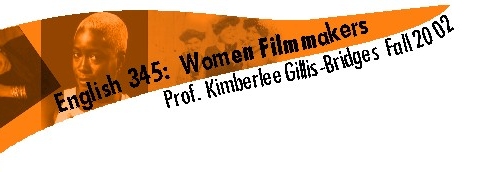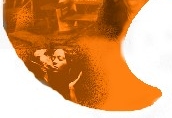


| Course M, 2:30-5:20 W, 2:30-4:20 Thomson 125 |
| Instructor K. Gillis-Bridges Padelford A305 543-4892 MW, 1:00-2:20 |
| Page last updated 12/10/02 |

Length and Due Dates
Length: 6-7 pages
Formatting: Please submit profiles on 8 ½" by 11" paper, titled, paginated, typed and double-spaced, with one-inch margins. In the upper right hand corner of the first page, include your name, the course number, the assignment, and the due date; this information should be single-spaced. You may use a 10 or 12 point Arial, Bookman, Century Schoolbook, or Times New Roman font for your papers. When incorporating sources, please use MLA guidelines
Assignment Option Due Dates: Submit via Word for PC email attachment or in hard copy at Padelford A-305 on:
- Friday, November 1, by 4:00 p.m.
- Monday, November 25, by 9:00 p.m.
- Monday, December 16, by 4:30 p.m.
A profile offers a six- to seven-page analysis of a director featured in class. Along with presenting a brief background on the filmmaker, a profile explores the themes, motifs, character types, or narrative and stylistic strategies that distinguish at least three of the director’s works. The analysis should engage critical responses to the director’s films and her characterization of her own work.
Writers must incorporate research into their profiles, using a minimum of four sources. These sources should include at least two scholarly books or articles, one of which may be a reading assigned for the course.
Guidelines and Expectations
1) You may submit a maximum of one profile. Profiles submitted on optional assignment due dates may address any filmmaker studied for the course.
2) Although I have provided a list of potential elements to include in your analysis, you will need to decide which of these elements is most significant to a discussion of the director’s work. You cannot cover all aspects of a director and her films in six to seven pages.
3) Effective profiles concentrate on analysis, revealing something important about the director and her films. Writers need to pose an argument about the significance of the commonalities they observe across the director’s films.
4) While profiles need to include both background and analysis, you can structure these elements in any way you wish. You may begin with a few sentences of background and incorporate additional biographical details as they support your analysis, or you can provide all biographical details in the first few paragraphs of the profile.
5) As you compose your analysis, remember that close examination of text will serve as your main source of evidence. In supporting your argument, you will need to pay attention to how the films use specific narrative and/or cinematic techniques, focusing on specific shots or scenes.
6) While you are drawing on sources to shape your profile, you should refrain from extensive source summary or quotation. References your sources when they help to support your point. The point of research isn’t to produce a document with strings of quotations that prove you’ve read sources. Think of your profile as being in dialogue with the writers you research. Include references to their work when you’re building on a point they have made or addressing an issue related to one of their arguments.
7) You are writing to an audience who has viewed at least one of the director’s films, but not all of them. Therefore, your may provide a few sentences of plot summary when discussing each film. However, the majority of reference to the films—dialogue quotations, scene descriptions, explanations of narrative movement—should support your analysis.
8) Do not forget the rich discussion that has taken place on the electronic bulletin board. A review of the postings on a particular film may help you to ask key questions and shape your analysis. You will, of course, cite specific words and interpretations borrowed from classmates.
9) If you’re having difficulty devising an approach to the profile, or if you want to discuss ideas-in-progress, come to my office hours or email me to set up an appointment.
Sample Profile
The linked profile offers a short biography of Margarethe von Trotta and addresses issues of public and private in three of her films: Marianne and Juliane,Rosa Luxemburg, and Sisters, or the Balance of Happiness. Along with analyzing von Trotta's treatment of the public and the private, the writer examines von Trotta's uses of flashbacks and the intersection of her films and German history.
Grading
I will use this grading scale to evaluate profiles.